Fungi: friend or foe? Erin Spear is in Panama to find out
![]() If you’re reading this somewhere in the U.S. or Canada right now, chances are most of the trees in the nearest forest belong to only four or five species. But if you’re lucky enough to be hanging out in the tropics, the forests near you tell a different story. In a tropical rainforest, an area the size of a baseball field can contain more than 166 different tree species!
If you’re reading this somewhere in the U.S. or Canada right now, chances are most of the trees in the nearest forest belong to only four or five species. But if you’re lucky enough to be hanging out in the tropics, the forests near you tell a different story. In a tropical rainforest, an area the size of a baseball field can contain more than 166 different tree species!
Diversity in a forest makes it resilient. In a diverse forest, different species are less likely to compete for the same resources or be affected in the same way by environmental challenges. Diversity makes it harder for diseases to spread from tree to tree, makes the forest more resilient after a forest fire and can help forests regrow in the wake of manmade or environmental disasters. In sum, diversity makes forests all-around healthier. Tracking so far?
Now, throw that all out the window because we’re here to tell you something unexpected: In certain ways, a healthy forest is also a diseased forest.
The fungus among us
Yeah, that’s right. Just ask Erin Spear, Staff Scientist at the Smithsonian Tropical Research Institute in Panama and director of the appropriately named DEATH Lab (Disease Ecology Across Tropical Habitats.) “[In our lab,] we are striving to understand why so many tree species can coexist,” she told Eye on Science. “Originally, people thought that [species] diversity was driven by light, water, and nutrients. But it became clear that the different ways trees use those things can’t explain how such a high number of tree species can coexist. We think their coexistence can be attributed to their interactions with other types of organisms.”
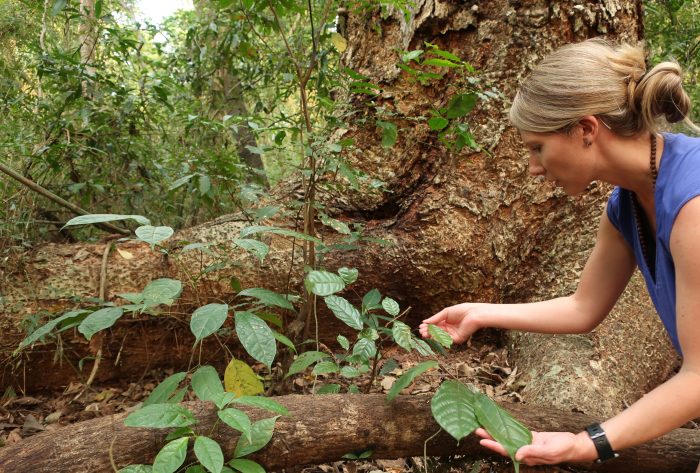
Erin Spear collects field samples from a Panamanian rainforest. (Photo courtesy Erin Spear)
And that’s where disease comes in. Those “other types of organisms” Erin is talking about are disease-causing fungi. Fungal diseases keep individual tree species in check, so the stronger ones don’t dominate and reduce the diversity of the forest. Erin studies why and how this happens.
But while fungal pathogens may be good for diverse forests, we cannot ignore what you’ve probably already thought of: Aren’t pathogens bad? Don’t fungi cause diseases in people, too? Yes, they do. But don’t worry, Erin is studying that, too. “Fungal infections kill more than four times as many people annually than malaria,” she said. “There’s a lot of attention on overcoming antibiotic resistance for human health, but we are facing the same problems with beneficial fungi because fungicides are being overapplied to crops.”
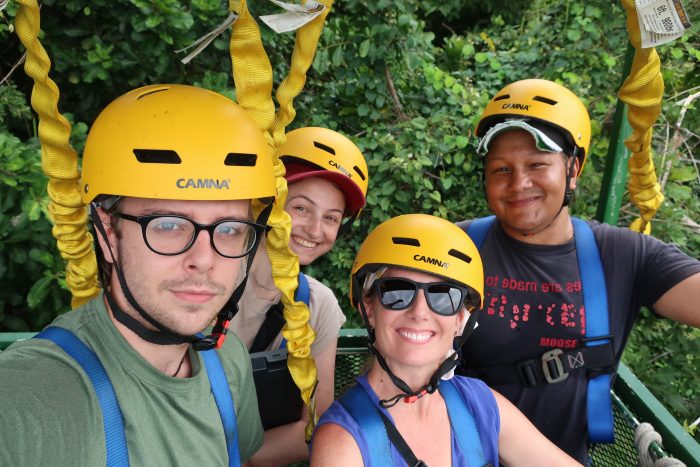
Erin Spear (center) and her research team take the canopy crane to the highest reaches of the rainforest to collect samples. (Photo courtesy Erin Spear)
To study this problem, Erin and her team use the canopy crane at STRI that sits in a national park in the heart of Panama City. As Erin and her colleagues ascend in the crane’s metal basket, they can collect samples from the tops of the trees to see what kinds of fungi live in the forest’s upper reaches. The conditions are bleak: the leaves at the top of the canopy are in full sun during the day, which exposes them to harmful UV rays and temperatures that can reach 118 degrees Fahrenheit. The fungi that can survive these temperatures are interesting to Erin because “the treetops could be reservoirs for fungi that can transition from plants to animals.”
Currently Erin’s team is identifying the fungi in the canopy versus those that exist in the forest’s understory. Next, they will analyze the DNA in the canopy fungi to find genetic variations that make them so resistant to high temperatures—the same variations that that make fungi dangerous to humans.
Risk of zombification?
If you’ve played the video game or watched the television series, The Last of Us, your mind might be heading in dark directions. For the uninitiated, the plot involves a fungus that evolves to infect humans, taking over their brains and turning them into zombies. (It’s the perfect entertainment when everyone is pretty much zombified after a big holiday meal.)
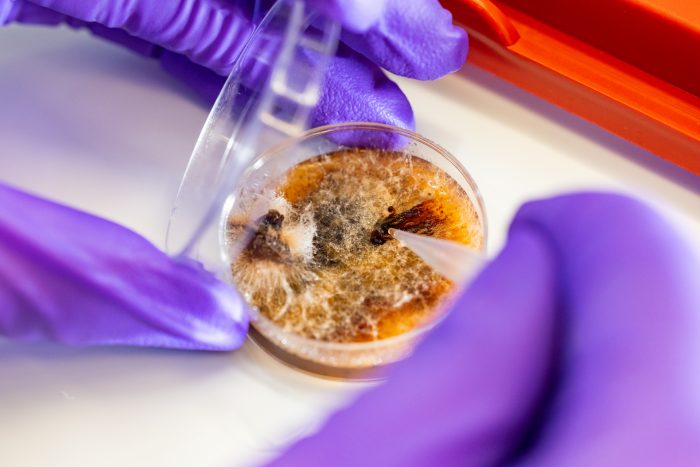
A fungus sample in the Disease Ecology Across Tropical Habitats laboratory at STRI.
But Erin says we shouldn’t freak out just yet. “I liked the show a lot, but I think the idea that something like that could happen is not super likely in the near future. But that doesn’t mean we shouldn’t be concerned. The reason fungal infections are so deadly is because people tend to catch them when they’re already sick. For instance, many people with COVID-19 got fungal infections and it was actually the fungus that killed them.”
Just to be safe, Erin and her team take precautions. “We wear gloves in a biosafety cabinet in sterile conditions,” she assured Eye on Science. “We follow high standards because of the few cases of the pathogenic fungi of plants infecting humans.”
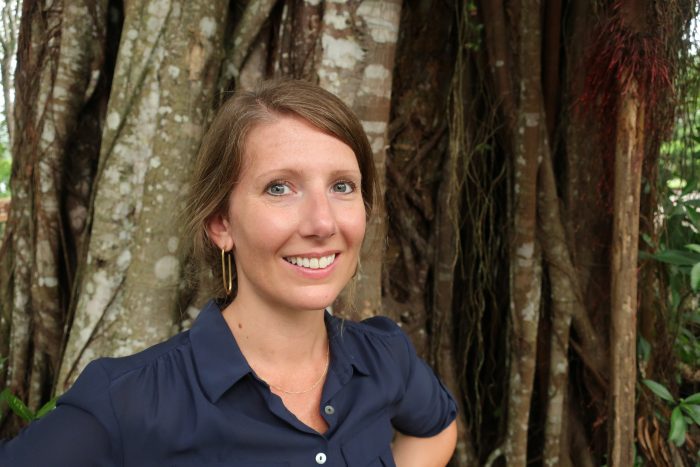
Erin says it’s unlikely a fungus will turn us all into zombies any time soon.
[Ed. note: It’s only a matter of time: It’s science: Zombies already walk among us]
Working in Panama
While death by fungus and zombification are interesting, let’s take a step back and appreciate the fact that Erin gets to perform her research in a tropical rainforest. Working in Gamboa, Panama “is like working inside a nature reserve. I feel so grateful that I have a rainforest right outside my office window.” Gamboa is just one site in Panama where Erin works. She also does research on Barro Colorado Island, an island formed when the Chagres River was dammed 100 years ago. The island hosts the most intensely studied forest in the world.
Erin isn’t originally from the tropics. So how did someone who was born in the U.S., studied in Utah, and worked in Washington, California, and Colorado end up studying fungus in Panama? “What better place to study plants than in a tropical forest?” she responds. During her doctoral studies at the University of Utah, Erin developed an interest in the role of disease in plants. Her interests veered in the direction of the disease-causing microbes and away from the plants themselves. “You sometimes take a winding path to find your one true love,” she said.
“I grew up at STRI,” Erin continued. “I came here as a grad student in 2009. We like to say that STRI implants magnets in people when they’re sleeping because everyone who comes here comes back.”
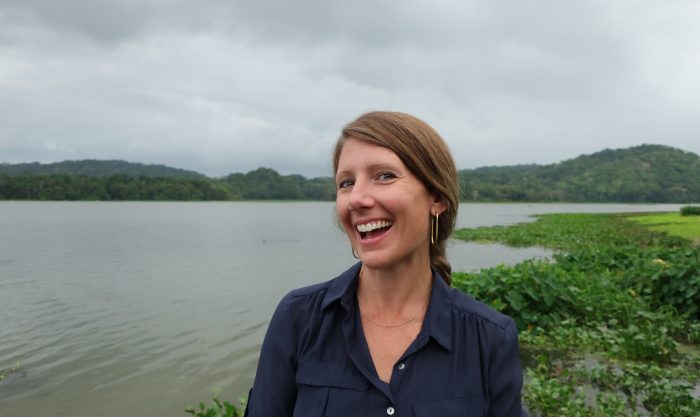
Fun with fungus: Erin Spear loves working in Panama (Photo courtesy Erin Spear)
Yes, the tropics may be beautiful, but what is it like to work in Panama day-to-day?
“Sometimes it tests my patience because there’s such a strong love of paperwork created by a combination of a bureaucracy-loving country plus the U.S. federal government.” It also takes a while to receive supplies, since the most effective method is by ship. But the rainforest itself makes up for the delays, Erin said. “My favorite thing, hands down, is rainforest. There’s no place that I’ve been so far that can compare to Panama. Everywhere I travel in Panama, nature is there. You can be in downtown Panama City and there will be mangroves growing there. The forest is always present. Nature is always present.”
But moving to Panama was a change, for sure. “Living here is a lot different than visiting. It was a big adjustment. I had to figure out opening a foreign bank account to pay my rent and buying a car and getting healthcare in a new language.”
But the move was worth it. “Here, if I decide on any given day I want to go to forest and do research, I can just do that. Also, I get to do experiments that no one else can do. It’s really hard to do long-term studies in tropical forests from the U.S. Working on Barro Colorado Island, on the other hand, there’s 100 years of research that’s already done. I get to draw upon that knowledge. It’s shaped my research trajectories and informed my conclusions.”
And her Spanish is getting better. “It’s improved so much, but it still feels like I know nothing. Fortunately, I have a really fabulous lab manager and he’s learning English. We go back and forth in Spanish and English—it’s really helped me get better at speaking Spanish.”

Eye on Science, our new biweekly series, will shine a light on our vast and varied body of work by bringing Smithsonian science into sharper focus. Eye on Science will tell the stories of the people behind the research, the discoveries they make and their inspiration. We will explore their passions, celebrate their contributions, and look more closely at how questions become solutions that can inform environmental policy, spur technological innovation, and promote community and collaboration across the globe.
Posted: 22 November 2023
-
Categories:
Eye on Science , Feature Stories , Tropical Research Institute







